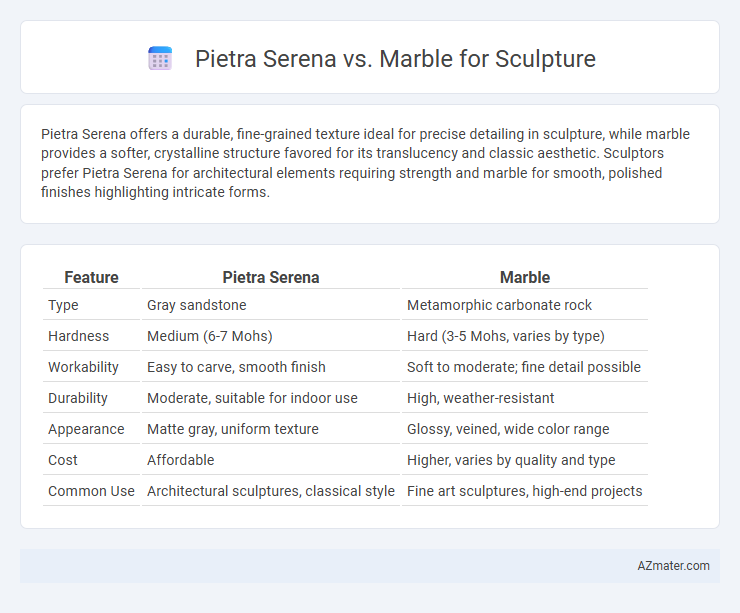Pietra Serena offers a durable, fine-grained texture ideal for precise detailing in sculpture, while marble provides a softer, crystalline structure favored for its translucency and classic aesthetic. Sculptors prefer Pietra Serena for architectural elements requiring strength and marble for smooth, polished finishes highlighting intricate forms.
Table of Comparison
| Feature | Pietra Serena | Marble |
|---|---|---|
| Type | Gray sandstone | Metamorphic carbonate rock |
| Hardness | Medium (6-7 Mohs) | Hard (3-5 Mohs, varies by type) |
| Workability | Easy to carve, smooth finish | Soft to moderate; fine detail possible |
| Durability | Moderate, suitable for indoor use | High, weather-resistant |
| Appearance | Matte gray, uniform texture | Glossy, veined, wide color range |
| Cost | Affordable | Higher, varies by quality and type |
| Common Use | Architectural sculptures, classical style | Fine art sculptures, high-end projects |
Introduction to Pietra Serena and Marble in Sculpture
Pietra Serena, a fine-grained, blue-gray sandstone, is prized in sculpture for its smooth texture and muted color, allowing detailed carving and subtle tonal contrasts. Marble, renowned for its crystalline structure and wide range of colors, offers translucency and softness that enhance lifelike detail and classical aesthetics in sculptures. Both stones provide unique material properties that influence texture, durability, and artistic expression in sculptural works.
Historical Significance of Pietra Serena and Marble
Pietra Serena, a fine-grained gray sandstone, was extensively used during the Renaissance in Florence, symbolizing classical elegance and local craftsmanship, as seen in works by Michelangelo and Brunelleschi. Marble, prized since ancient Greece and Rome, represents timeless luxury and durability, forming the basis of iconic sculptures like Michelangelo's David and the Parthenon marbles. Both materials embody significant cultural heritage, with Pietra Serena reflecting regional identity and marble conveying universal artistic prestige.
Physical Characteristics: Pietra Serena vs Marble
Pietra Serena is a fine-grained, medium-density sandstone known for its uniform gray color and moderate porosity, making it easier to carve and less prone to cracking during sculpting. Marble, typically composed of recrystallized carbonate minerals, offers a smooth, dense, and highly durable surface with a distinctive veining pattern, providing both strength and a polished finish ideal for detailed work. The lower density and softer texture of Pietra Serena allow for intricate sculpting with less effort, while marble's hardness enhances longevity and the ability to achieve sharp, precise details.
Workability and Carving Techniques Compared
Pietra Serena, a dense Tuscan sandstone, offers excellent workability due to its fine grain and consistent texture, allowing sculptors to achieve sharp details and smooth finishes with relative ease. Marble, particularly Carrara marble, is prized for its translucency and isotropic qualities, enabling intricate carving and the creation of delicate, flowing forms through traditional chiseling and polishing techniques. While marble requires slower, more precise tools to avoid fracturing, Pietra Serena's robustness supports both dynamic chiseling and machine carving, making it versatile for both intricate and large-scale sculptures.
Aesthetic Qualities: Color, Texture, and Finish
Pietra Serena offers a distinctive ash-gray color with fine grain texture, providing a smooth, matte finish ideal for subtle, modern sculptures. Marble presents a wider color palette, ranging from pure white to deep hues with natural veining, creating a polished, reflective surface suited for classical and luxurious aesthetics. Sculptors choose Pietra Serena for understated elegance and durability, while marble is prized for its luminous quality and intricate visual depth.
Durability and Longevity in Outdoor and Indoor Settings
Pietra Serena, a dense, fine-grained sandstone, offers exceptional durability and resistance to weathering, making it ideal for both outdoor and indoor sculptures exposed to fluctuating environmental conditions. Marble, known for its classic beauty and smooth texture, is more susceptible to erosion and acid rain damage over time, especially in outdoor settings with high pollution or moisture. For longevity, Pietra Serena provides superior structural integrity outdoors, while marble remains favored indoors where its vulnerability to elements is minimized.
Maintenance Requirements for Pietra Serena and Marble Sculptures
Pietra Serena sculptures demand moderate maintenance due to their porous nature, requiring regular sealing and gentle cleaning to prevent staining and weathering. Marble sculptures, while less porous, are susceptible to acid rain and pollutants, necessitating periodic professional cleaning and protective treatments to maintain their aesthetic integrity. Both materials benefit from controlled environments that minimize exposure to harsh elements, but marble typically requires more specialized conservation efforts due to its crystalline structure.
Cost Considerations: Pietra Serena vs Marble
Pietra Serena is significantly more affordable than marble, making it a preferred choice for budget-conscious sculptors and large-scale projects. Marble's higher cost is attributed to its rarity, extraction difficulty, and polish quality, which elevates its market price substantially. Sculptors must balance budget constraints against the desired aesthetic and durability when choosing between Pietra Serena and marble.
Sustainability and Environmental Impact
Pietra Serena, a durable Tuscan sandstone, offers a lower environmental impact compared to marble due to its local availability and less intensive quarrying processes, resulting in reduced carbon emissions. Marble, often quarried internationally, involves higher transportation emissions and energy-intensive extraction, increasing its carbon footprint. Choosing Pietra Serena supports sustainable sculpture practices through minimized resource consumption and localized sourcing, promoting environmental conservation.
Choosing the Right Stone for Your Sculpture
Pietra Serena, a fine-grained gray sandstone from Tuscany, offers excellent workability and a matte finish, making it ideal for detailed sculptures with a natural, understated look. Marble, valued for its smooth texture and translucency, provides a classic, luminous quality that enhances intricate carving and polished surfaces. Choosing between Pietra Serena and marble depends on desired aesthetic, durability, and the sculpture's intended setting, as marble suits refined elegance while Pietra Serena supports robust, earthy designs.

Infographic: Pietra Serena vs Marble for Sculpture
 azmater.com
azmater.com